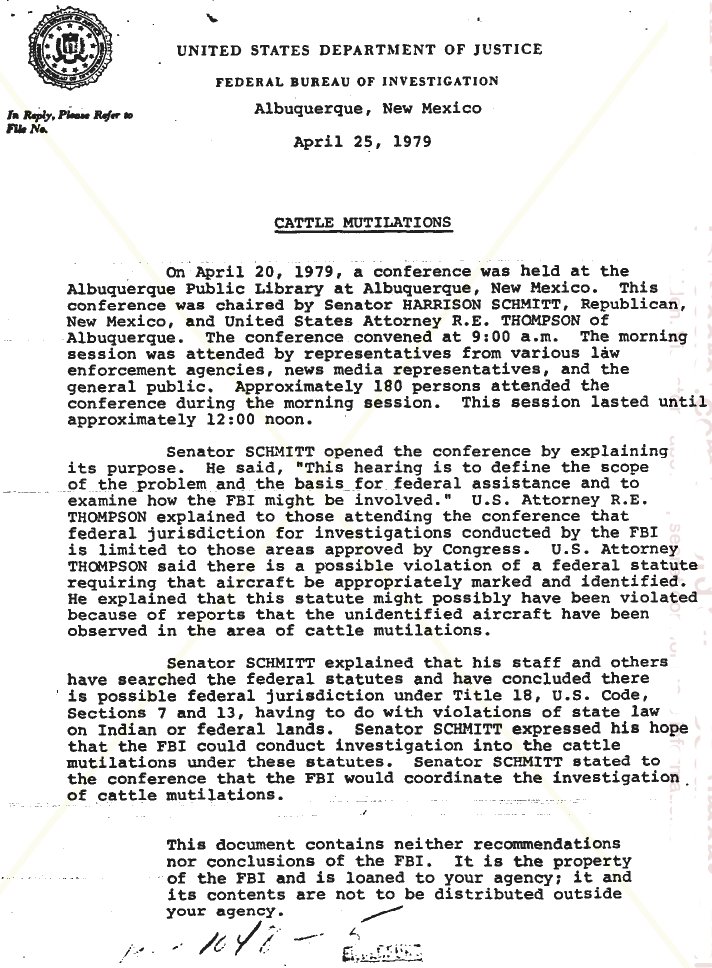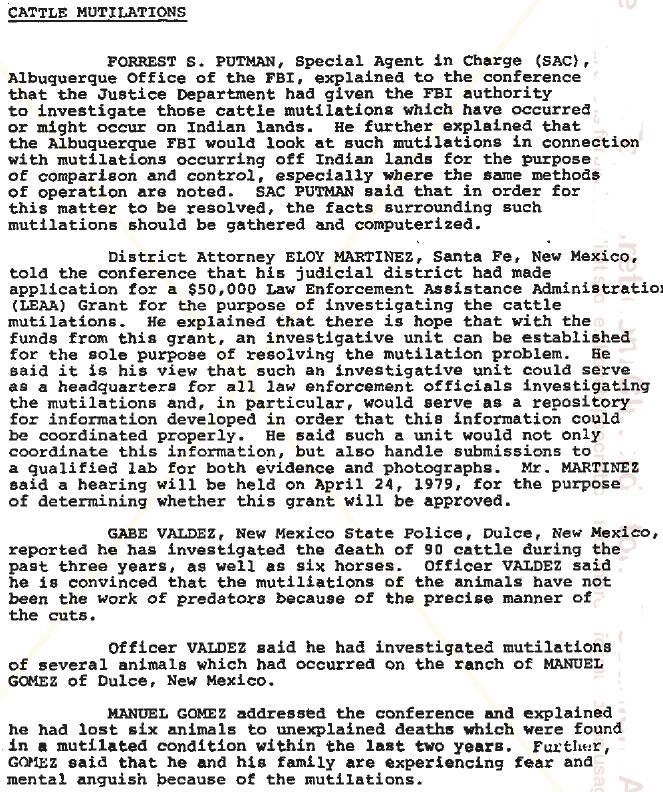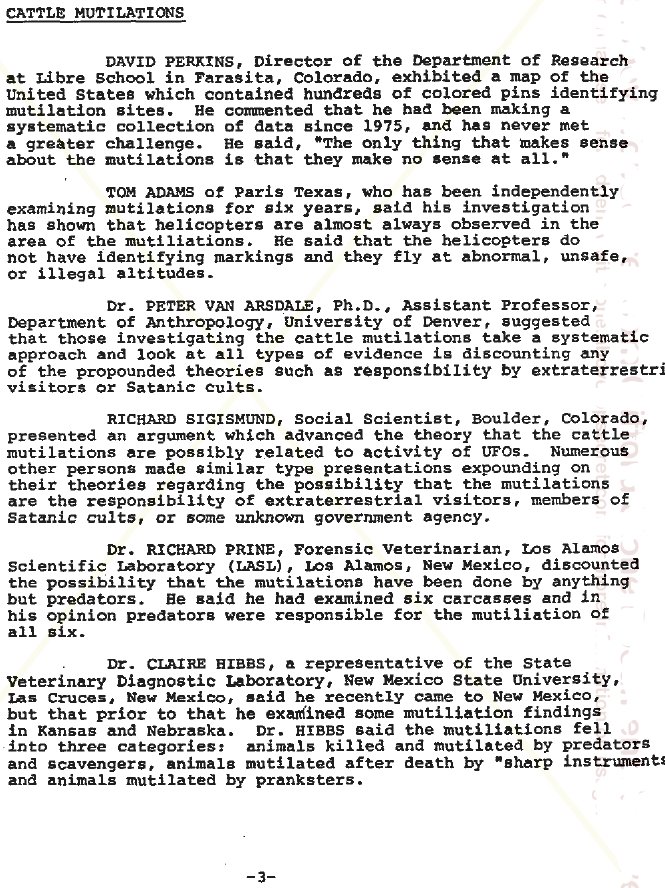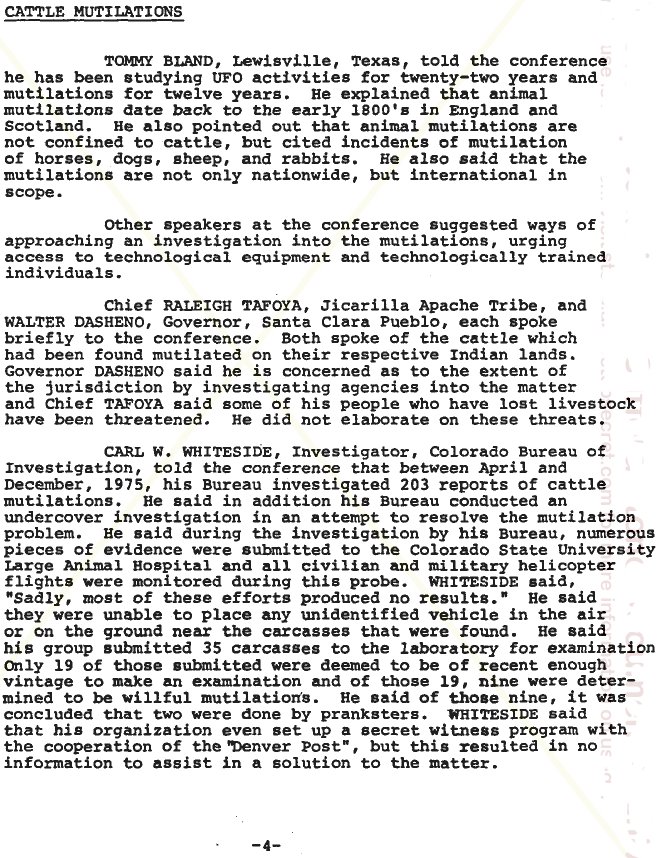
On April 20, 1979, a conference was held at the Albuquerque Public Library at Albuquerque, New Mexico. This conference was chaired by Senator Harrison Schmitt, Republican, New Mexico, and United States Attorney R. E. Thompson of Albuquerque. The conference convened at 9:00 a.m. The morning session was attended by representatives from various law enforcement agencies, news media representatives, and the general public. Approximately 180 persons attended the conference during the morning session. This session lasted until approximately 12:00 noon.
Senator Schmitt opened the conference by explaining its purpose. He said, "This hearing is to define the scope of the problem and the basis for federal assistance and to examine how the FBI might be involved." U.S. Attorney R. E. Thompson explained to those attending the conference that federal jurisdiction for investigations conducted by the FBI is limited to those areas approved by Congress. U.S. Attorney Thompson said there is a possible violation of a federal statute requiring that aircraft be appropriately marked and identified. He explained that this statute might possibly have been violated because of reports that the unidentified aircraft have been observed in the area of cattle mutilations.
Senator Schmitt explained that his staff and others have searched the federal statutes and have concluded there is possible federal jurisdiction under Title 18, U.S. Code, Sections 7 and 13, having to do with violations of state law of Indian or federal lands. Senator Schmitt expressed his hope that the FBI could conduct investigation into the cattle mutilations under these statutes. Senator Schmitt stated to the conference that the FBI would coordinate the investigation of cattle mutilations.

Forest S. Putman, Special Agent in Charge (SAC), Albuquerque Office of the FBI, explained to the conference that the Justice Department had given the FBI authority to investigate those cattle mutilations which have occured or might occur on Indian lands. He further explained that the Albuquerque FBI would look at such mutilations in connection with mutilations occuring off Indian lands for the purpose of comparison and control, especially where the same methods of operation are noted. SAC Putman said that in order for this matter to be resolved, the facts surrounding such mutilations should be gathered and computerized.
District Attorney Eloy Martinez, Santa Fe, New Mexico, told the conference that his judicial district had made application for a $50,000 Law Enforcement Assistance Administration (LEAA) Grant for the purpose of investigating the cattle mutilations. He explained that there is hope that with the funds from this grant, an investigative unit can be established for the sole purpose of resolving the mutilation problem. He said it is his view that such an investigative unit could serve as a headquarters for all law enforcement officials investigating the mutilations and, in particular, would serve as a repository for information developed in order that this information could coordinate properly. He said such a unit would not only coordinate this information, but also handle submissions to a qualified lab for both evidence and photographs. Mr. Martinez said a hearing will be held on April 24, 1979, for the purpose of determining whether this grant will be approved.
Gabe Valdez, New Mexico State Police, Dulce, New Mexico, reported he has investigated the death of 90 cattle during the past three years, as well as six horses. Officer Valdez said he is convinced that the mutilations of the animals have not been the work of predators because of the precise manner of the cuts.
Officer Valdez said he had investigated mutilations of several animals which had occured on the ranch of Manuel Gomez of Dulce, New Mexico.
Manuel Gomez addressed the conference and explained he had lost six animals to unexplained deaths which were found in a mutilated condition within the last two years. Further, Gomez said that he and his family are experiencing fear and mental anguish because of the mutilations.

David Perkins, Director of the Department of Research at Libre School in Farasita, Colorado, exhibited a map of the United States which contained hundreds of colored pins identifying mutilation sites. He commented that he had been making a systematic collection of data since 1975, and had never met a greater challenge. He said, "The only thing that makes sense about the mutilations is that they make non sense at all."
Tom Adams of Paris Texas, who has been independently examining mutilations for six years, said his investigation has shown that helicopters are almost always observed in the area of the mutilations. He said that the helicopters do not have identifying markings and they fly at abnormal, unsafe, or illegal altitudes.
Dr. Peter Van Arsdale, Ph.D., Assistant Professor, Department of Anthropology, University of Denver, suggested that those investigating the cattle mutilations take a systematic approach and look at all types of evidence is discounting any of the propounded theories such as responsibility by extraterrestrial visitors or Satanic cults.
Richard Sigismund, Social Scientist, Boulder, Colorado, presented an argument which advanced the theory that the cattle mutilations are possibly related to activity of UFOs. Numerous other persons made similar type presentations expounding on their theories regarding the possibility that the mutilations are the responsibility of extraterrestrial visitors, members of Satanic Cults, or some unknown government agency.
Dr. Richard Prine, Forensic Veterinarian, Los Alamos Scientific Laboratory (LASL), Los Alamos, New Mexico, discounted the possibility that the mutilations have been done by anything but predators. He said he had examined six carcasses and in his opinion predators were responsible for the mutilation of all six.
Dr. Claire Hibbs, a representative of the State Veterinary Diagnostic Laboratory, New Mexico State University, Las Cruces, New Mexico, said he recently came to New Mexico, but that prior to that he examined some mutilation findings in Kansas and Nebraska. Dr. Hibbs said the mutilations fell into three categories: animals killed and mutilated by predators and scavengers, animals mutilated after death by "sharp instruments" and animals mutilated by pranksters.

Tommy Bland, Lewisville, Texas, told the conference he has been studying UFO activities for twenty-two years and mutilations for twelve years. He explained that animal mutilations date back to the early 1800's in England and Scotland. He also pointed out that animal mutilations are not confined to cattle, but cited incidents of mutilation of horses, dogs, sheep, and rabbits. He also said that the mutilations are not only nationwide, but international in scope.
Other speakers at the conference suggested ways of approaching an investigation into the mutilations, urging access to technological equipment and technologically trained individuals.
Chief Raleigh Tafoya, Jicarilla Apache Tribe, and Walter Dasheno, Governor, Santa Clara Pueblo, each spoke briefly to the conference. Both spoke of the cattle which has been found mutilated on their respective Indian lands. Governor Dasheno said he is concerned as to the extent of the jurisdiction by investigating agencies into the matter and Chief Tafoya said some of his people who have lost livestock have been threatened. He did not elaborate on these threats.
Carl W. Whiteside, Investigator, Colorado Bureau of Investigation, told the conference that between April and December, 1975, his Bureau investigated 203 reports of cattle mutilations. He said in addition his Bureau conducted an undercover investigation in an attempt to resolve the mutilation problem. He said during the investigation by his Bureau, numerous pieces of evidence were submitted to the Colorado State University Large Animal Hospital and all civilian and military helicopter flights were monitored during this probe. Whiteside said, "Sadly, most of these efforts produced no results." He said they were unable to place any unidentified vehicle in the air or on the ground near the carcasses that were found. He said his group submitted 35 carcasses to the laboratory for examination. Only 19 of those submitted were deemed to be of recent enough vintage to make an examination and of those 19, nine were determined to be willful mutilations. He said of those nine, it was concluded that two were done by pranksters. Whiteside said that his organization even set up a secret witness program with the cooperation of the "Denver Post", but this resulted in no information to assist in a solution to the matter.

During the afternoon of April 20, 1979, law enforcement officers met with U.S. Attorney R. E. Thompson for a special meeting. At this conference were representatives from the FBI and numerous state law enforcement officers from New Mexico. Also in attendance were investigators from Nebraska, Colorado, Montana and Arkansas. During the conference emphasis was placed on an attempt to determine the most appropriate way of approaching the solution of the cattle mutilations. The officials decided that direction for the investigation should be the responsibility of one of three agencies — the FBI, the District Attorney's Office in Santa Fe, New Mexico, which has applied for the LEAA Grant, or the New Mexico State Police. U.S. Attorney Thompson concluded the within the next two weeks a determination would be made which of the three agencies would be the primary investigative group and the agency's responsibility for the collection of data regarding the mutilations. U.S. Attorney Thomson pointed out that the FBI would have to receive approval from Washington, District Attorney Martinez' group would have to receive the LEAA Grant and the New Mexico State Police would have to obtain clearance from its headquarters.
During this session of the conference, investigators from Arkansas pointed out that they have examined 28 cases of cattle mutilations and it is their conclusion that all cases were the work of intentional mutilators and not of predators. The examination of carcasses submitted by their investigators have been done by the Oklahoma State University Forensic Lab.
The investigator present at the conference from Montana expressed his opinion that carcasses found in Montana were also mutilated by deliberate efforts and not by predators.
All investigators present during this session recommended that there be a central collection unit which could coordinate information from all areas. Also, all investigators recommended that a standard procedure and from be adopted for the investigation of future mutilations. They recommended that evidence be examined by a qualified veterinary pathologist.